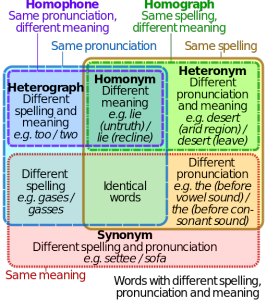The Difference Between Homonyms, Homophones And Homographs

One of things which helps to make the trio of the words homonyms, homophones and homographs confusing is their prefix. The prefix of each word is homo and it derives from the Greek word ‘homos’ which means “one and the same.” In literal terms, it would mean “same name.” That means that all of these 3 words somehow describe things with identicalness. Another issue which causes some confusion about these three words, is the differences of opinions found by some professors, teachers and linguists. Since homonyms are often used by many to unsystematically describe either a homophone or homograph, it can tends to cause mix-ups.
What Is A Homonym?
When it comes to spelling or talking about words, both their spelling and pronunciation needs to be taken into consideration. Because of that , homonyms are defined as two or more words which share the same pronunciation and/or the same spelling. However, the words have totally different meanings. Some authors tend to use them more broadly, and because of that, homonyms end up falling in the same category of homographs and homophones. Where it gets confusing for many, is that certain people actually define homonyms as homophones. But true homonyms are spelled the same.
Prime examples of homonyms would be –
Can – (as in “can I help you?”)
Can – (as in a can of soda)
Duck – (as in the bird)
Duck – (as in to stoop, bend or try to avoid a blow)
Tip – (as in the pointy end, a small piece)
Tip – (as in falling over, stumble)
Tip – (as in what you leave waiters, or a useful hint)
One example of a homonym used in a sentence would be –
“Even though she is the sole heir to her father’s shoes collection, the girl has no sole in one shoe.”
Need more help with this subject? Then check out Principle vs. Principal – Which To Use?
What Is A Homophone?
Homophones are two words or more which have the same pronunciation. However, they have different spelling, meanings or origins. One of the reasons the homophone and homonym meanings are often confused, is because it all depends on who you ask or listen to. Unlike homonyms (which sound and are spelled the same), homophones, are not.
Prime examples of homophones would be –
Aid – (as in helping someone)
Aide – (an assistant or helper)
Flair – (meaning natural talent or ability)
Flare – (a torch, candle)
Hole – (like an opening in the wall)
Whole – (total, full, entire)
One example of a homophone used in a sentence would be –
“I write about the bad way this girl makes me feel which just isn’t right.”
What Is A Homograph?
Homographs are words which are spelled exactly the same way, but have totally different meaning. Moreover, they are often pronounced differently or distinctively as well. Since there are many authors or writers which treat the three terms in similar fashions, many people get confused. Still, true homographs are both visible in spelling and often heard in their pronunciation.
Prime examples of homographs would be –
Desert – (as in an area with nothing but sand, wasteland)
Desert – (as in to abandon someone, fail in time of need)
Bass – (as in music)
Bass – (as in a fish)
Wind – (as in the air, storm)
Wind – (as in to coil or twine, or wind a clock)
One example of a homograph used in a sentence would be –
“Can you please record my favorite program about the person trying to beat the world record for spelling. homographs?”
Here are Six Important Grammar Rules You Need To Know
Due to the nature of the many different ways people use and choose to explain these three words, it is easy to be confused. However, just remember that homonyms are multiple meaning words that sound alike, are spelled the same, but have different meanings. For the homophones, just think of the ‘phone’ at the end of the word, which means sound or voice. Thus they have the same pronunciation.
Lastly, homonyms and homographs are actually spelled the same or identical, unlike homophones.
